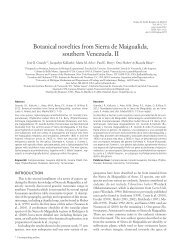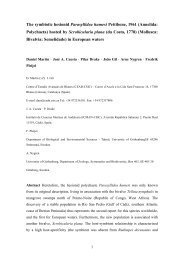FUNCTIONAL AND BIOACTIVE PROPERTIES OF COLLAGEN AND ...
FUNCTIONAL AND BIOACTIVE PROPERTIES OF COLLAGEN AND ...
FUNCTIONAL AND BIOACTIVE PROPERTIES OF COLLAGEN AND ...
Create successful ePaper yourself
Turn your PDF publications into a flip-book with our unique Google optimized e-Paper software.
Meisel, 2003). The ACE inhibitory activity described for collagen and gelatin hydrolysates and<br />
peptides may be related to the high concentration of hydrophobic amino acids, as well as to high Pro<br />
levels. This amino acid seems to be one of the most effective for increasing ACE inhibitory activity<br />
and has been identified in many of the naturally occurring ACE peptide inhibitors (Gómez-Ruiz,<br />
Ramos & Recio, 2004ab; Quirós et al., 2007; Pihlanto, Akkanen & Korhonen, 2008; Contreras,<br />
Carrón, Montero, Ramos & Recio, 2009), especially in those derived from collagenous sources (Table<br />
2) (Byun & Kim, 2001; Kim et al., 2001c; Saiga et al., 2008; Ichimura et al., 2009; Shimizu et al.,<br />
2010; Alemán et al., 2011b).<br />
The in vivo effects of antihypertensive peptides are usually tested in spontaneously hypertensive rats<br />
(SHR), which constitute an accepted model for human essential hypertension (Fitz-Gerald, Murray, &<br />
Walsh, 2004). Many of the ACE inhibitory peptides isolated from collagenous sources have already<br />
been tested in vivo, and an antihypertensive effect has been reported. SHR experienced a significant<br />
decrease in blood pressure following oral administration of both a chicken leg collagen hydrolysate<br />
and the isolated octapeptide Gly-Ala-Hyp-Gly-Leu-Hyp-Gly-Pro (Cheng et al., 2009; Iwai, Saiga-<br />
Egusa, Hayakawa, Shimizu, Takahata & Morimatsu, 2008; Saiga et al., 2008). Furthermore, Faria, da<br />
Costa, Gontijo and Netto (2008) found that bovine and porcine collagen hydrolysates produced a<br />
considerable reduction in blood pressure in SHR after oral administration. In another study, the blood<br />
pressure of renal hypertensive rats was significantly reduced by administering the lowest fraction of<br />
sea cucumber gelatin hydrolysate (Zhao et al., 2007). ACE inhibitory peptides Gly-Pro and Gly-Phe-<br />
Hyp-Gly-Pro, isolated from porcine skin collagen hydrolysate also had an antihypertensive effect on<br />
SHR (Ichimura et al., 2009).<br />
6.- Conclusions<br />
Gelatin production from alternative non-mammalian species had grown in importance, largely as a<br />
way to valorise by-products from fish and poultry industrial processes. Regarding fish origin, tropical<br />
and sub-tropical warm-water species might have similar rheological properties and thermostability to<br />
that of mammal gelatins; therefore, they could be used for similar applications. Recently, an<br />
increasing number of new applications have been found for gelatin or collagen in products such as<br />
emulsifiers, foaming agents, colloid stabilizers, hydrogels, fining agents, biodegradable packaging<br />
materials, micro-encapsulating agents, as well as bioactive peptides, in line with the growing trend to<br />
replace synthetic agents with more natural ones. The main source for collagen or gelatin extraction<br />
from fish are skins and bones, however more recently they have been also extracted from scales and<br />
fins, processed fish offal, as well as from other aquatic organisms such as red sea cucumber or<br />
alligators. The huge number of available species had made necessary to adapt the extraction<br />
procedures in order to optimize the properties of the resulting material (in the form of collagen or<br />
gelatin). In the last decade, further improvement of the characteristics of low-gelling gelatins from<br />
24

















